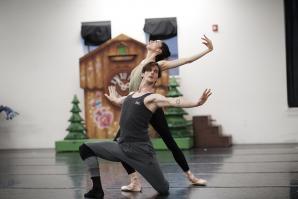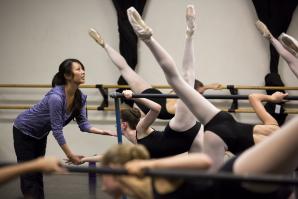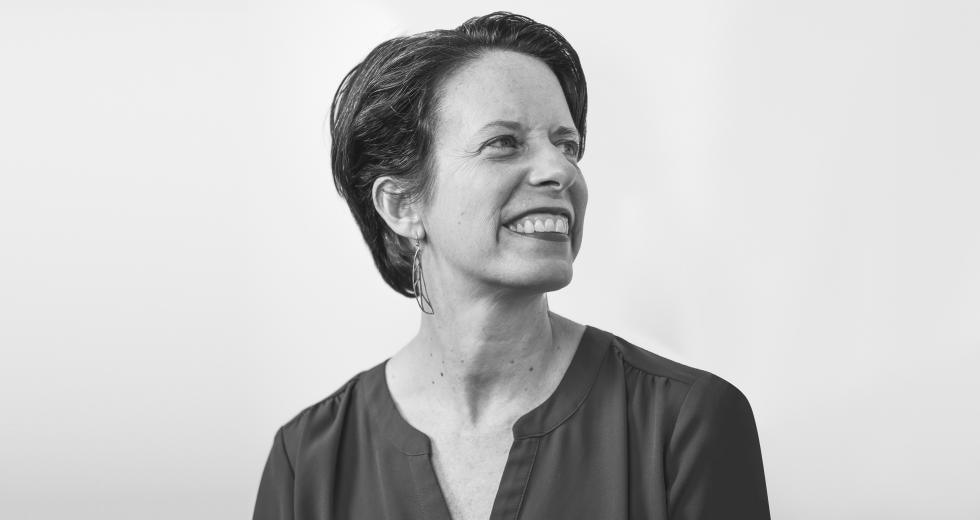Amy Seiwert is only the fourth artistic director in the Sacramento Ballet’s 65-year history. Seiwert — who danced with the company from 1991 to 1999 — assumed the role in July 2018. Comstock’s recently spoke with Seiwert about her vision and goals for the ballet.
Your inaugural season, “Roots and Wings,” is nearing completion. What were you hoping to achieve during your first season, and did you achieve it?
Coming in after 30 years of [co-artistic directors] Ron Cunningham and Carinne Binda, it is very important for me to honor that lineage. … We did [Cunningham’s] “Incident at Blackbriar,” in our first series at The Sofia theater, “Telling Stories.” To have him back in the studio and with the dancers and to watch him coach, that was all fantastic. Honor the lineage — that’s the roots aspect. But … where else can we go? How can I subvert people’s expectations of what they’re going to see when they come to a Sacramento Ballet performance? Also in “Telling Stories,” we did the ballet “Instructions,” which is based on a Neil Gaiman poem. He’s more associated with contemporary mythology and graphic novels than ballet. In that piece, I have a dancer who is live miked. He starts as the narrator of the poem and ends up locked inside the poem and becomes the protagonist of the story. It’s also got live music — there’s a cellist onstage.
I think we are accomplishing the goals of the season, artistically, also as an organization. We’ve had a bit of turmoil in our history, so it’s also about rebuilding the community that likes us and wants to invest in us and support these fantastic artists. That’s just going to take time. I think a lot of people are waiting to see what the ballet means now under my leadership, and I’m just hoping they’ll fall in love.
Related: Choreographing Change
What was the response from the dancers when they found out one of them was going to be asked to narrate?
[It’s] not a standard thing to ask. … I come in with this printed poem for them to play with, and some were very eager to try. There were a couple that basically said I’m highly uncomfortable doing this, I don’t want to. That’s fine. Making you highly uncomfortable is not my goal. There’s a very clear line between pushing someone as an artist and just making them feel horrible. The dancer who ended up performing that is Isaac Bates-Vinueza, and Isaac was brilliant.
Tell me about the last program of this season.
“Fast Forward” is the last program of this year, and that will be mid-May at The Sofia. It’s called “Fast Forward” to point out that we’re looking at the classical ballet language and seeing where else it can lead. It’s three choreographers — all three are still alive, still creating. One is Val Caniparoli, who was also our choreographic mentor for “Beer and Ballet,” and it’s his piece “The Bridge,” with the music of Shostakovich. It is an incredibly heartbreaking story, but it’s insanely beautiful. And Annabelle Lopez Ochoa, her piece is called “Written and Forgotten,” and it’s super whimsical and surprising. It has a lot of elements you don’t normally see in a ballet. She’s another choreographer in incredible demand right now working worldwide, and she will be here in the studio with our dancers, so that’s a pretty big coup. And the third piece will be “World Premiere” by me, and it is working with violist Christen Lien, who is based in Los Angeles, and she will be performing live onstage with us.
How much does the ballet’s annual budget of $2.9 million figure into your artistic decisions?
If you look into my office, you’re going to see a wall full of different [Post-it] notes that are my dream ballets [and] the people I want to commission to … work with our dancers. It’s me looking at the timeline for when is this company going to be ready to do “Swan Lake” again? When is the right time for these things? If we can’t afford to do a ballet it doesn’t matter how great it is, we have to wait until we can. The same thing goes artistically. When we have the right dancers to do the right ballet, that matters. We’re not only planning next season. We’re looking at, OK, in three years this artist is going to be ready to do that ballet; can I get us that ballet in three years?
Is $2.9 million a decent budget for a ballet?
We’re a little on the smaller side, but we are hoping to grow in a sustainable way. … Historically, this company has not been great in terms of a solid living wage for their artists and pay equity, and these are two things that are very important to me. The financial reality is we can’t fix that overnight, but that is a long-term goal to really address both of those issues, and we are working on it.
[In terms of equity], back in 2012, I was being interviewed by the San Francisco Chronicle because a project I was doing in San Francisco had all women choreographers. I said there was a lack of women in leadership positions in ballet. This reviewer challenged me. I said to him in 19 years as a professional dancer on a mainstage, I danced one piece by a woman. … Since then, the field is changing, the conversation is changing. I do believe it has reached a tipping point, and I think this next generation of female choreographers coming up is going to have a lot more opportunity than I did, and that is great. We [also] talk about the lack of diversity on our stages — if the only people doing these jobs are the ones who don’t have to make a living doing it, everyone is going to look a certain way. So if we want to talk about diversity we have to talk about a living wage for artists.
What do today’s ballet audiences want, and how does your approach fit?
I think all performing arts are dealing with this right now. We currently as a society have access to so much media, so cheaply, if you’re going to convince people to leave their house and their Netflix and their glass of wine and they’re in their pajamas [to] come out to see a show, you have to be able to offer an entire experience. For “Beer and Ballet” we had Ruhstaller pouring beer, and you get to come in and have your beer and watch these dancers from literally like 7 feet away [in the front row]. We’re also looking to expand the arch of engagement, so when you come to see the ballet, you’re not just here for two hours and not thinking of us before and after. We want to be able to send you videos and different interviews with the choreographers, sneak peeks [of] rehearsal.
We’re also starting to do a lot of Second Saturday stuff, where we invite people to come in and watch a little bit of our process. … I think people are looking for different access points, different ways to understand ballet, different ways to experience ballet. I think for some people ballet feels like you need a secret handshake to understand it. Or they saw a ballet once and didn’t get it. So if you can offer the access points, sometimes you see the lightbulb go off.
How do you balance being inventive and embracing change with pleasing longtime patrons?
I did a new “Nutcracker” this year, which was so much fun. Me being a middle-aged woman in America, there were things that were very important for me to say in “Nutcracker” that were potentially “nontraditional.” For example, there’s a point in the party scene when the music is very sweet, it’s like a lullaby, and very often you see all the girls rocking the dolls that they just received, and a cacophony happens, and all the boys come through and make a ruckus and disrupt everything. It was very important to me that both girls and boys make a ruckus, because sometimes girls are loud [laughs]. Especially if you’re going to do this ballet that is the most performed ballet in the United States and that a lot of children are seeing, that they’re not seeing stereotypical gender roles of kids, and not all the girls are sweet and all the “boys will be boys.” I’m going to say 95 percent of the audience didn’t even notice. … There is [also] a moment when Marie has been attacked by the mice, and the music has this big change, and very often in that moment someone comes out and saves her. In my version, no one comes to her rescue, and she sits on the ground and she cries for a little while, and then she stands up and she moves on. … If you look at this ballet, it had all traditional ballet steps, it had traditional ballet costumes, it had traditional ballet music. But I think we can tell the stories with a contemporary mindset to what we’re trying to say.
Tell me about the importance of “Beer and Ballet” in terms of cultivating the next generation of talent?
It is truly an investment in fostering new choreographic voices, and they are the future of our artform, so I’d say this is incredibly important. This was a program that was started by Ron Cunningham and Carinne Binda about 25 years ago — I was a choreographer in the very first one. It’s a workshop, which means the pieces are all created by our dancers. This year, we have 10 pieces. There is one young man, he’s 19, and this is the first piece he has ever made. When they are choreographing, they pick their music, they decide their intention or the story they are telling, they work with our lighting designer, they work with our costume department. The thing I always think is most important is they are tasked, as the leader of the room, to foster the entire environment of the room. It’s so important and it takes practice. When you’re a dancer, you are receiving the information, interpreting it and putting it back out. When you’re in the front of the room [as the choreographer], what you learn is incredibly valuable, and then you go back to being a dancer and receiving the information with what you just learned, and you become a better performing artist. So even if someone tries choreography and says they never want to do it again, they are now a better performing artist for that experience. Choreographic workshops are so important; they’re also really rare. Because they cost resources and we are, of course, a nonprofit and being able to invest in that development is a challenge.
Tell me about developing the second season — how do you go about that process?
We’re in a little bit of a unique situation because the Community Center Theater is going to be under renovation and things moving to the Memorial [Auditorium]. It’s a bit of an unknown of how that’s going to play out, so that’s a challenge. Fortunately, we have a second home now at [The Sofia, Home of B Street], and that’s a great place to see us — the ballet looks really, really good there. With the ballets that we do, I want them to have the mix between classical storytelling and contemporary storytelling. For example, we did Stephen Mills’ “Hamlet” this past spring. The company has done Ron Cunningham’s “Great Gatsby.” These [are] full-length, awesome narrative works, but that aren’t quite in the total classical realm. So looking to the future of how we can continue to build those pieces — they’re very expensive to do. How do we dream creatively within our pocket book is something that I’m extremely cognizant of. Our audience is a mix of people who want those full-length stories and who want more cutting-edge works.
In addition to bringing you on recently, the ballet’s board also brought on a new executive director and board chair. Changes in arts leadership don’t happen very often. How have you navigated that transition?
I have leaned on a lot of people in the field that I respect greatly. I have a lot of solid mentorships. Andrew Roth, who is our board chair, came on. He started going through a book of “The Practice of Adaptive Leadership” for us, to give us tools. I’ve looked a lot into change management. That was really my preparation for this year, and then once you’re in the year you just put your head down and work. I think the transition in leadership is like so many things. It’s — for lack of a better word — weirder or more awkward than when it’s actually happening. Because when it’s happening, we’re all working. These dancers have been nothing but welcoming and supportive, and they’re dealing with so much change as well. But at the end of the day, we all love our artform, and we all want what is best for our field.
Recommended For You

Tradition Refresh
Sacramento Ballet’s “The Nutcracker” gets a new marketing perspective for a fresh take on holiday classic
Sometimes even beloved traditions get an update, like the Sacramento Ballet’s annual holiday production of “The Nutcracker,” which offers a new take on the classic story this year.

Choreographing Change
BlyueRose Dance Project offers low-cost dance to Oak Park youth
In Sacramento’s Oak Park neighborhood, community dance lives, thanks to identical twin sisters Heather and Holly Singleteary, co-founders of the BlyueRose Dance Project at the Instituto Mazatlan de Bellas Artes.

A Dancer’s Destiny
In the studio with Sacramento Ballet prinicpal Melanie Haller
As a student, Melanie Haller trained for 12 years at the internationally-recognized Central Pennsylvania Youth Ballet under world-renowned ballet teacher Marcia Dale Weary. Now, as principal of the School of the Sacramento Ballet, Haller trains the Pre-Professional Division — the school’s three highest levels (ages 10 to 18-and-up).



